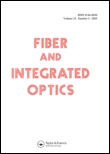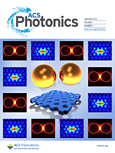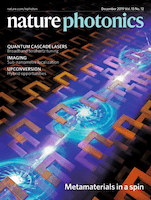
Plasmonics
Scope & Guideline
Unveiling the Mysteries of Nanoscale Interactions
Introduction
Aims and Scopes
- Surface Plasmon Resonance (SPR) Sensors:
The journal covers the design, development, and application of SPR sensors for detecting various biological and chemical analytes. This includes advancements in sensitivity and specificity for medical diagnostics, environmental monitoring, and food safety. - Plasmonic Materials and Nanostructures:
Research on various plasmonic materials such as gold, silver, and novel 2D materials like graphene and MXenes is a core focus. The journal emphasizes the synthesis, characterization, and application of these materials in enhancing plasmonic effects. - Metamaterials and Metasurfaces:
The exploration of engineered metamaterials and metasurfaces that manipulate light at subwavelength scales, enabling novel optical devices and sensors. This includes studies on tunable and reconfigurable metasurfaces for various applications. - Theoretical and Computational Studies:
The journal supports theoretical and computational research that models plasmonic phenomena, improving the understanding of light-matter interactions and guiding experimental designs. - Applications in Sensing and Imaging:
Applications of plasmonics in sensing and imaging technologies, particularly for biomedical applications, environmental monitoring, and chemical detection, are of significant interest. - Photonic Devices and Energy Harvesting:
Research on integrating plasmonic structures into photonic devices, including solar cells, photodetectors, and thermal absorbers, to enhance efficiency and performance.
Trending and Emerging
- 2D Materials and Hybrid Systems:
The integration of 2D materials, such as graphene and MXenes, with plasmonic systems is gaining traction, highlighting their unique optical properties and potential for advanced sensing applications. - Machine Learning and AI in Sensing:
The application of machine learning and artificial intelligence techniques to optimize sensor performance and predict outcomes in plasmonic sensing is on the rise, reflecting a broader trend in data-driven research. - Plasmonic Biosensors for Health Diagnostics:
There is a notable increase in the development of plasmonic biosensors specifically designed for health diagnostics, particularly for early disease detection and monitoring, driven by the global health landscape. - Environmental and Sustainability Applications:
Research focusing on the use of plasmonics for environmental monitoring and sustainable practices, such as pollutant detection and energy harvesting, is becoming increasingly prominent. - Enhanced Photothermal Therapy:
The application of plasmonic materials in enhancing photothermal therapy for cancer treatment is emerging, with studies focusing on the synergistic effects of plasmonic heating and drug delivery.
Declining or Waning
- Traditional Bulk Plasmonics:
Research focused on bulk plasmonic effects has decreased as the field shifts towards nanostructured and hybrid materials that offer enhanced properties and functionalities. - Low-Dimensional Materials without Plasmonic Enhancement:
Studies on low-dimensional materials that do not leverage plasmonic enhancement mechanisms have declined, as the focus has shifted towards materials that exhibit strong plasmonic characteristics. - Conventional Optical Devices:
The exploration of conventional optical devices that do not incorporate plasmonic elements is less frequent, as the field progresses towards integrating plasmonics with cutting-edge technologies.
Similar Journals

Chemosensors
Unlocking the Potential of Chemical SensorsChemosensors is a distinguished open-access journal published by MDPI, focusing on the innovative field of analytical chemistry and physical and theoretical chemistry. Since its inception in 2013, the journal has rapidly established itself as a pivotal platform for the dissemination of cutting-edge research related to the development and application of chemical sensors, encompassing various methodologies and technologies that contribute to advancements in diagnostics, environmental monitoring, and industrial applications. Based in Switzerland, the journal operates with a commitment to accessibility, ensuring that all published articles are freely available to a global readership. With a current impact factor that positions it in the Q2 quartile for both Analytical Chemistry and Physical and Theoretical Chemistry, Chemosensors attracts a diverse audience of researchers, professionals, and students eager to explore new findings and foster collaborative efforts in sensor technology and its applications. As it continues to grow, Chemosensors remains devoted to advancing scientific knowledge and innovation in its field, making significant contributions to the global scientific community through its rigorous peer-review process.

Light-Science & Applications
Exploring the Frontiers of Optics and Materials ScienceLight-Science & Applications is a prestigious open-access journal published by SPRINGERNATURE, dedicated to advancing the fields of Atomic and Molecular Physics, Optics, and Electronic, Optical, and Magnetic Materials. Established in 2012 and located in the United Kingdom, this journal has rapidly gained recognition, evidenced by its impressive 2023 rankings; it is situated in Q1 within its categories, boasting a rank of #5 out of 224 in Physics and Astronomy and #8 out of 284 in Materials Science, placing it in the esteemed 97th percentile. It is committed to disseminating high-quality research that explores innovative applications of light and materials science, making it an invaluable resource for researchers, professionals, and students alike. As an open-access platform, Light-Science & Applications ensures that its research is freely accessible, fostering collaboration and knowledge exchange within the scientific community. With its converged years spanning from 2012 to 2024, the journal remains at the forefront of impactful developments in light science.

FIBER AND INTEGRATED OPTICS
Connecting Ideas in Integrated Optics and BeyondFIBER AND INTEGRATED OPTICS is a prominent academic journal published by TAYLOR & FRANCIS INC, focusing on the cutting-edge domains of optical and fiber technologies. Since its inception in 1977, the journal has journeyed through expansive developments in the fields of Atomic and Molecular Physics, as well as Electronic, Optical, and Magnetic Materials, boasting a converged publication history extending to 2024. With a solid reputation reflected in its Q3 rankings in both aforementioned categories, FIBER AND INTEGRATED OPTICS serves as an essential platform for researchers, professionals, and students to disseminate and explore innovative findings and methodologies. Although currently not offering Open Access, its scholarly contributions remain invaluable, fostering a deeper understanding and advancements in fiber optic applications and integrated optical systems. Situated in the United Kingdom, the journal continues to attract a diverse global audience, solidifying its significance in contemporary scientific discourse.

SENSORS AND ACTUATORS B-CHEMICAL
Exploring Breakthroughs in Materials Science.SENSORS AND ACTUATORS B-CHEMICAL, published by ELSEVIER SCIENCE SA, is a premier scientific journal that occupies a vital niche in the field of materials science and engineering. With an impressive impact factor and ranking in the Q1 category across multiple disciplines, including Condensed Matter Physics, Electrical and Electronic Engineering, and Materials Chemistry, this journal is recognized as a leading source of innovative research and developments in sensor technologies and their chemical applications. The journal disseminates high-quality articles with a focus on the design, fabrication, and application of sensors and actuators, promoting valuable insights that cater to researchers, professionals, and students alike. As a testament to its scholarly significance, SENSORS AND ACTUATORS B-CHEMICAL remains pivotal for those seeking to advance their understanding of electronic, optical, and magnetic materials. The journal is accessible primarily through subscription, ensuring a wide reach to the academic community, and contributing significantly to the ongoing exploration and interdisciplinary collaboration in this dynamic field.

ACS Photonics
Connecting Theory to Application in PhotonicsACS Photonics, published by the American Chemical Society, is a leading journal dedicated to advancing the interdisciplinary fields of photonics and optics. Since its inception in 2014, the journal has swiftly established itself as a premier platform for the dissemination of groundbreaking research, achieving a distinguished Q1 ranking across several categories including Atomic and Molecular Physics, Biotechnology, Electrical and Electronic Engineering, and Electronic, Optical and Magnetic Materials. With an impressive Scopus Rank and notable percentiles—ranking 19th in Atomic and Molecular Physics and 32nd in Biotechnology—the journal continues to shape the dialogue surrounding innovations in laser technology, optical materials, and biophotonic applications. While the journal does not currently offer open access options, it remains a vital resource for researchers, professionals, and students seeking to explore the cutting-edge developments in this dynamic field. Located in Washington, DC, ACS Photonics is committed to bridging theoretical insights with practical applications, making significant contributions to science and technology.

JOURNAL OF OPTOELECTRONICS AND ADVANCED MATERIALS
Exploring New Horizons in Optoelectronics and Advanced MaterialsJOURNAL OF OPTOELECTRONICS AND ADVANCED MATERIALS, published by the NATL INST OPTOELECTRONICS in Romania, is an esteemed academic journal dedicated to disseminating innovative research in the fields of optoelectronics and advanced materials. With an ISSN of 1454-4164 and E-ISSN 1841-7132, the journal provides a platform for researchers to share their findings and technological advancements from 1999 to 2024. Despite being placed in the Q4 quartile across several categories—including Atomic and Molecular Physics, Condensed Matter Physics, and Electrical and Electronic Engineering—the journal serves as an essential resource for highlighting significant developments in its respective fields. Researchers and professionals may find valuable insights that foster collaboration and inspire further investigation, thereby contributing to the continuous evolution of optoelectronics and materials science.

Nature Photonics
Driving the Evolution of Photonics through Collaborative ResearchNature Photonics, published by NATURE PORTFOLIO, stands as a leading journal in the realm of photonics, specializing in the convergence of atomic and molecular physics and optics, as well as electronic, optical, and magnetic materials. Established in 2007 and continuing through 2024, this esteemed journal boasts an impressive 2023 ranking of Q1 in both its primary categories, highlighting its importance and influence within the scientific community. With a Scopus rank of #3 in both materials science and physics categories, and a remarkable 99th percentile ranking, Nature Photonics serves as a vital platform for disseminating pioneering research and innovative discoveries that drive the field forward. Although it does not currently offer open access options, the journal remains accessible to a broad audience interested in the latest advancements in photonics, including researchers, professionals, and students eager to explore cutting-edge developments. By fostering a community of collaboration and knowledge exchange, Nature Photonics continually shapes the future of photonics research.

Photonic Sensors
Empowering Research through Open Access in PhotonicsPhotonic Sensors is a premier open access journal published by Springer, focusing on the rapidly evolving fields of Photonics, Materials Science, and Optics. Since its inception in 2011, this journal has become a vital platform for disseminating cutting-edge research and innovative applications in photonic technologies, addressing a range of topics from optical sensors to advanced materials for photonics. With an impressive impact factor and categorized in the Q2 quartile across both Atomic and Molecular Physics and Electronic, Optical and Magnetic Materials, it ranks among the top publications in its field (47th out of 284 and 38th out of 224, respectively, in Scopus). The journal actively encourages contributions that not only advance theoretical understanding but also pave the way for practical solutions in various industries. Photonic Sensors is essential reading for researchers, professionals, and students keen on exploring the frontiers of photonic research, with open access ensuring wide visibility and engagement within the scientific community.

Optoelectronics Letters
Showcasing Breakthroughs in Optical and Electronic MaterialsOptoelectronics Letters, published by Tianjin University of Technology, is an esteemed platform for the dissemination of innovative research within the fields of atomic and molecular physics, optics, condensed matter physics, and electrical engineering. With its inaugural publication in 2007 and a convergence period extending to 2024, this journal aims to foster scholarly communication and collaboration among researchers and professionals. Although currently lacking an impact factor, it serves a vital niche in the rapidly evolving field of optoelectronics, evidenced by its categorization in the fourth quartile for various physics disciplines and the third quartile in electrical and electronic engineering. Given its ranking dynamics in Scopus, it is an emerging choice for authors seeking to convey their findings on electronic, optical, and magnetic materials. Researchers, students, and industry professionals alike can benefit from its open access options, encouraging a broad dissemination of cutting-edge knowledge that is essential in the advancement of technology and materials science.

ZEITSCHRIFT FUR NATURFORSCHUNG SECTION A-A JOURNAL OF PHYSICAL SCIENCES
Advancing the Frontiers of Physical SciencesZEITSCHRIFT FUR NATURFORSCHUNG SECTION A - A JOURNAL OF PHYSICAL SCIENCES is a distinguished journal published by Walter de Gruyter GmbH, based in Germany, that serves as a vital platform for research in the realms of mathematical physics, physical and theoretical chemistry, and broader disciplines within physics and astronomy. Established in 1946, this journal has been a cornerstone for scientists and researchers, providing rigorous peer-reviewed articles that push the boundaries of knowledge in physical sciences. With a notable 2023 Scopus ranking reflecting its respected position in the field—Q3 in mathematical physics, physical and theoretical chemistry, and miscellaneous physics and astronomy—this journal not only emphasizes high-quality research but also enhances the visibility and impact of contributions within these areas. Although it does not currently offer open access, the insights shared in its pages are invaluable for advancing academic inquiry and sparking interdisciplinary collaborations. As it looks ahead to 2024, ZEITSCHRIFT FUR NATURFORSCHUNG SECTION A continues to invite contributions that align with its mission to foster an understanding of complex physical phenomena, making it an essential resource for academics, professionals, and students alike.